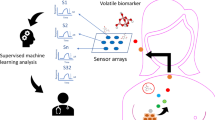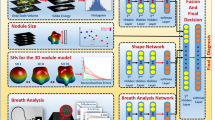Abstract
Conventional diagnostic methods for lung cancer1,2 are unsuitable for widespread screening2,3 because they are expensive and occasionally miss tumours. Gas chromatography/mass spectrometry studies have shown that several volatile organic compounds, which normally appear at levels of 1–20 ppb in healthy human breath, are elevated to levels between 10 and 100 ppb in lung cancer patients4,5,6. Here we show that an array of sensors based on gold nanoparticles can rapidly distinguish the breath of lung cancer patients from the breath of healthy individuals in an atmosphere of high humidity. In combination with solid-phase microextraction7, gas chromatography/mass spectrometry was used to identify 42 volatile organic compounds that represent lung cancer biomarkers. Four of these were used to train and optimize the sensors, demonstrating good agreement between patient and simulated breath samples. Our results show that sensors based on gold nanoparticles could form the basis of an inexpensive and non-invasive diagnostic tool for lung cancer.
This is a preview of subscription content, access via your institution
Access options
Subscribe to this journal
Receive 12 print issues and online access
$259.00 per year
only $21.58 per issue
Buy this article
- Purchase on Springer Link
- Instant access to full article PDF
Prices may be subject to local taxes which are calculated during checkout




Similar content being viewed by others
References
Jemal, A. et al. Cancer statistics, 2008. CA Cancer J. Clin. 58, 71–96 (2008).
Culter, D. M. Are we finally winning the war on cancer? J. Eco. Perspec. 22, 3–26 (2008).
Banerjee, A. K., Rabbitts, P. H. & George, J. Lung cancer * 3: fluorescence bronchoscopy: clinical dilemmas and research opportunities. Thorax 58, 266–271 (2003).
O'Neill, H. J., Gordon, S. M., O'Neill, M. H., Gibbons, R. D. & Szidon, J. P. A computerized classification technique for screening for the presence of breath biomarkers in lung cancer. Clin. Chem. 34, 1613–1618 (1988).
Yu, H. et al. Detection of volatile organic compounds in breath as markers of lung cancer using a novel electronic nose. Proc. IEEE Sens. 2, 1333–1337 (2003).
Phillips, M. et al. Volatile organic compounds in breath as markers of lung cancer: a cross-sectional study. Lancet 353, 1930–1933 (1999).
Ouyang, G. & Pawliszyn, J. SPME in environmental analysis. Anal. Bioanal. Chem. 386, 1059–1073 (2006).
Cao, W. & Duan, Y. Current status of methods and techniques for breath analysis. Crit. Rev. Anal. Chem. 37, 3–13 (2007).
Amann, A., Spanel, P. & Smith, D. Breath analysis: the approach towards clinical applications. Mini-Rev. Med. Chem. 7, 115–129 (2007).
Smith, D., Wang, T., Sulé-Suso, J., Spane, P. & El-Haj, A. Quantification of acetaldehyde released by lung cancer cells in vitro using selected ion flow tube mass spectrometry. Rapid Commun. Mass Spectrom. 17, 845–850 (2003).
Kamat, P. C. et al. Measurement of acetaldehyde in exhaled breath using a laser absorption spectrometer. Appl. Opt. 46, 3969–3975 (2007).
Giubileo, G. Medical diagnostics by laser-based analysis of exhaled breath. Proc. SPIE 4762, 318–325 (2002).
Di Natale, C. et al. Lung cancer identification by the analysis of breath by means of an array of non-selective gas sensors. Biosens. Bioelectron. 18, 1209–1218 (2003).
Machado, R. F. et al. Detection of lung cancer by sensor array analyses of exhaled breath. Am. J. Respir. Crit. Care Med. 171, 1286–1291 (2005).
Dragonieri, S. et al. An electronic nose in the discrimination of patients with non-small cell lung cancer and COPD. Lung Cancer 64, 166–170 (2009).
Mazzone, P. J. et al. Diagnosis of lung cancer by the analysis of exhaled breath with a colorimetric sensor array. Thorax 62, 565–568 (2007).
Baubach, J. I., Vautz, W. & Ruzsanyi, V. Metabolites in Human Breath: Ion Mobility Spectrometers as Diagnostic Tools for Lung Diseases. (World Scientific, 2005).
Kneepkens, C. M. F., Lepage, G. & Roy, C. C. The potential of the hydrocarbon breath test as a measure of lipid peroxidation. Free Rad. Biol. Med. 17, 127–160 (1994).
Amorimb, L. C. A. & Cardeal, Z. L. Breath air analysis and its use as a biomarker in biological monitoring of occupational and environmental exposure to chemical agents. J. Chromatogr. B 853, 1–9 (2007).
Wojciech, F. et al. Release of volatile organic compounds (VOCs) from the lung cancer cell line CALU-1 in vitro. et al. Cancer Cell Int. 8, 1–11 (2008).
Roeck, F., Barsan, N. & Weimar, U. Electronic nose: Current status and future trends. Chem. Rev. 108, 705–725 (2008).
Haick, H. Chemical sensors based molecularly modified metallic nanoparticles. J. Phys. D 40, 7173–7186 (2007).
Joseph, Y., Guse, B., Vossmeyer, T. & Yasuda, A. Gold nanoparticle/organic networks as chemiresistor coatings: the effect of film morphology on vapor sensitivity. J. Phys. Chem. C 112, 12507–12514 (2008).
Ibañez, F. J. & Zamborini, F. P. Chemiresistive sensing of volatile organic compounds with films of surfactant-stabilized gold and gold-silver alloy nanoparticles. ACS Nano 2, 1543–1552 (2008).
Ebeler, S. E., Clifford, A. J. & Shibamoto, T. Quantitative analysis by gas chromatography of volatile carbonyl compounds in expired air from mice and human. J. Chromatogr. B 702, 211–215 (1997).
Peng, G., Trock, E. & Haick, H. Detecting simulated patterns of lung cancer biomarkers by random network of single-walled carbon nanotubes coated with non-polymeric organic materials. Nano Lett. 8, 3631–3635 (2008).
Peng, G., Tisch, U. & Haick, H. Detection of nonpolar molecules by means of carrier scattering in random networks of carbon nanotubes: toward diagnosis of diseases via breath samples. Nano Lett. 9, 1362–1368 (2009).
Brust, M., Fink, J., Bethell, D., Schiffrin, D. J. & Kiely, C. J. Synthesis and reactions of functionalised gold nanoparticles. J. Chem. Soc. Chem. Commun. 1655–1656 (1995).
Acknowledgements
The research was funded by the Marie Curie Excellence Grant of the European Commission's FP6 program (grant no. 1006752), the Alfred Mann Institute (grant no. 1007920), the Israel Cancer Association (grant no. 2009837) and the Technion's Russell Berrie Nanotechnology Institute (grant no. 76517704/14). We thank E. Dovgolevsky, O. Marom, C. Attalah and I. Dvorkind for assistance. H.H. holds the Horev Chair for Leaders in Science and Technology.
Author information
Authors and Affiliations
Contributions
H.H. conceived and designed the experiments. G.P. fabricated the sensors, performed the sensing experiments and analysed the pertinent data. O.A. conducted the synthesis and characterization of gold nanoparticles. M.H. conducted the GC-MS experiments. N.Sh. and U.B. collected the breath samples and investigated the effect of clinical characteristics of healthy volunteers. S.B., R.A.-B. and A.K. obtained the volunteers and diagnosed them clinically. U.T. and H.H. analysed the data and wrote the paper. All authors discussed the results and commented on the manuscript.
Corresponding author
Supplementary information
Supplementary information
Supplementary information (PDF 541 kb)
Rights and permissions
About this article
Cite this article
Peng, G., Tisch, U., Adams, O. et al. Diagnosing lung cancer in exhaled breath using gold nanoparticles. Nature Nanotech 4, 669–673 (2009). https://doi.org/10.1038/nnano.2009.235
Received:
Accepted:
Published:
Issue Date:
DOI: https://doi.org/10.1038/nnano.2009.235
This article is cited by
-
Augmenting insect olfaction performance through nano-neuromodulation
Nature Nanotechnology (2024)
-
Data-centric artificial olfactory system based on the eigengraph
Nature Communications (2024)
-
Chemiresistive sensing with functionalized carbon nanotubes
Nature Reviews Methods Primers (2023)
-
A chemiresistive-potentiometric multivariate sensor for discriminative gas detection
Nature Communications (2023)
-
Perspectives and trends in advanced optical and electrochemical biosensors based on engineered peptides
Microchimica Acta (2023)



